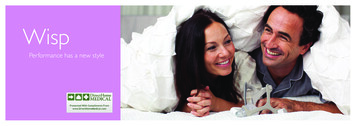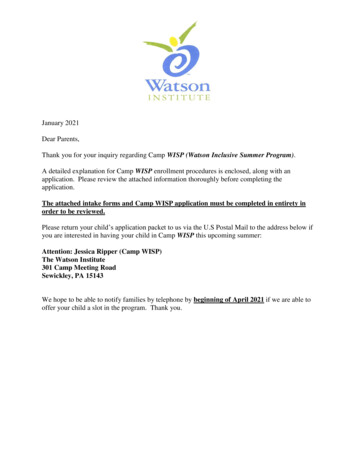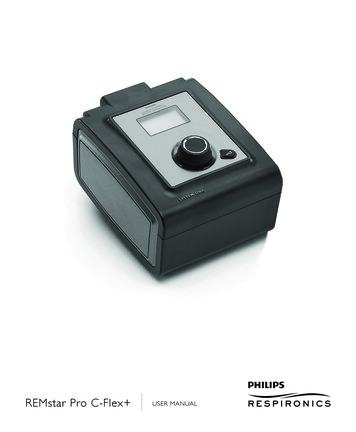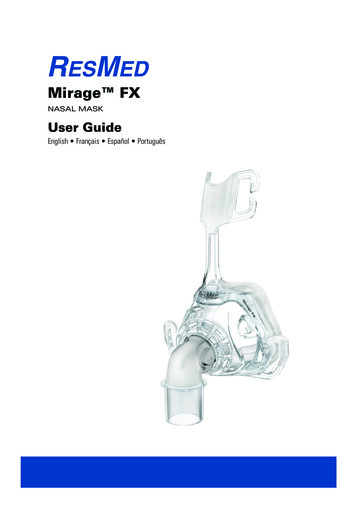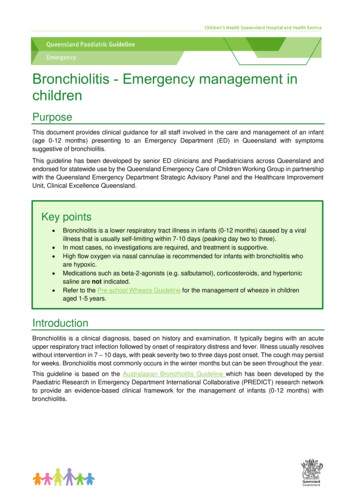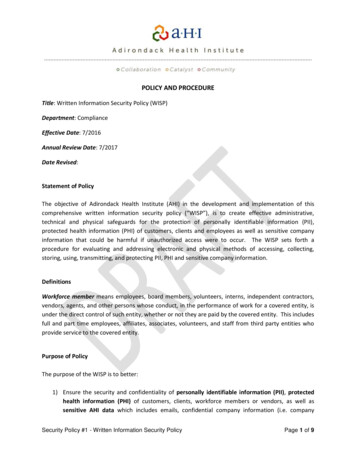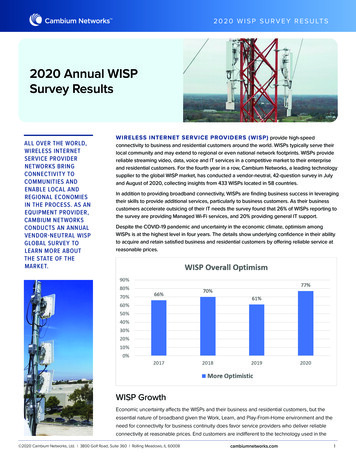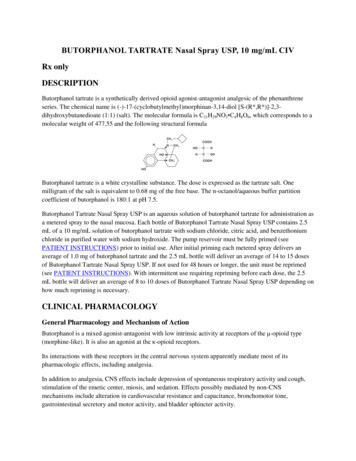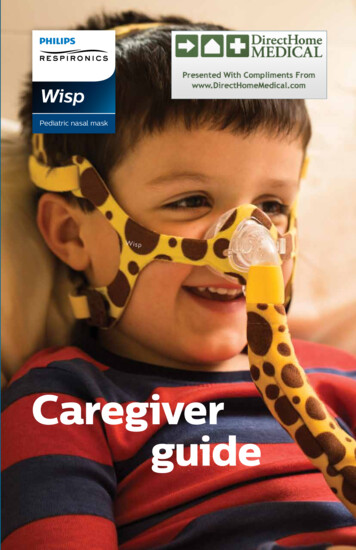
Transcription
WispPediatric nasal maskCaregiverguide
Support for familiesThe Wisp pediatric mask has a fun, child-friendly giraffe print and soft, fabric materials. Wehave created a fantasy world featuring our cartoon giraffe character, Jacky, who interacts withhis friends Sami the Seal and Tucker the Turtle. The purpose of this playful theme is to helpease the child into therapy and make him or her comfortable with the mask.Caregivers can access demonstration videos to help them use the mask, while the child canenjoy the Jacky Giraffe adventure cartoon.DreamMapper* (www.dreammapper.com)is a mobile and web application that keepsyou actively informed about the child’stherapy. You can find information onthings like mask fit and therapy hours,and watch demonstration videos andJacky’s animated cartoon.The animated cartoon and demonstrationvideos can also be accessed on thePhilips Respironics YouTube channel,philips.to/wisppediatric.*To see which therapy devices are compatible with DreamMapper, visit www.dreammapper.com/compatible.
Dear parents and caregivers,We are glad that this guide has reached you. We know that managing and navigating achild’s therapy can be daunting at times. There are a lot of new things to learn–a mask, amachine, supplies, and practically a whole dictionary of new terminology! It is our hope thatthis guidebook will answer many of your questions and explain the information in a clearand concise way. It is a support tool to help you, the caregiver, feel more comfortable usingand maintaining the child’s new mask and supplies.This guide is not intended to replace the Instructions for Use packaged with the child’smask and equipment. The Instructions for Use contain many important safety warningsand instructions that should be read and followed. This guide expands on the informationfound there and provides additional details to address some of the questions thatcaregivers may have.Any problems encountered during treatment should be discussed with the child’s doctor.We hope that this guide will help ease the transition into non-invasive ventilation therapy.Sincerely,Cyndi White, MSc, RRT-NPS, AE-C, CPFT, FAARCMegan King, Global Product Manager, Philips Respironics
Introduction toNon-invasive ventilation If you are reading this guide, there is a good chance that the child may neednon-invasive ventilation (NIV) now or in the near future. The type of NIV therapy received depends on the child’s specific conditionand individual needs. The child’s physician will evaluate and determine theproper treatment. Therapy will be given through a small machine that will be used to helpsupport the child’s breathing (refer to the image below).Benefits NIV helps to keep the child’s airway open andprevent it from collapsing or becoming obstructed. Preventing obstruction and airway collapseallows the child to get more oxygen which isimportant for their brain and growing body. NIV uses two levels of pressure to help supportair in and out of the lungs and remove wastethrough effectively breathing in and out. The “back-up rate” is a set breathing rate that keeps the child’s breathing ata certain number of breaths per minute. This feature will activate only if thechild’s breathing falls below the set rate.
Learn your way around theWisp pediatric maskThe headgear wrapsaround the headand attaches to theframe. It holds themask in place andkeeps it stable.The frame rests against theface and holds the cushionin place on the mask.The tubing managementloop is an optional featurethat enables the tube tobe positioned over thehead and away from thefront of the body.The tube wrap is anoptional part thatenhances the giraffeprint theme.
The cushion, which isavailable in differentsizes, fits over the noseto deliver therapy.The headgear clips allowthe mask to be removedwithout readjusting theheadgear tabs each time.The quick release tabson the elbow allow thechild to be temporarilydisconnected from themachine, such as to usethe bathroom in themiddle of the night.The elbow and tubeconnect the mask tothe hose on the therapydevice. The tube providesextra length for the childto change positionswhile sleeping.
Spotlight on theLeak Correction DialThe innovative Leak Correction Dial on the child’s Wisp pediatric maskenables you to fix small leaks. It should always be positioned straight down,as if pointing at the 6 on a clock, when the child puts on the mask. The maskshould be fitting properly and without leaks at the time the child goes to bed.The Leak Correction Dial can be turned to the right or left if leaks occur whilethe child is sleeping to readjust the fit of the cushion on the face. Turningthe Leak Correction Dial widens the angle of the front of the frame, gentlynudging the cushion closer to the face.
Care and maintenance Wash the mask parts in warm water with liquid dishwashing soap, like whatyou might use when hand-washing your dishes. Do not clean the mask withbleach, alcohol, solutions containing bleach or alcohol, or solutionscontaining conditioners or moisturizers. Hand wash the non-fabric parts (the cushion and tubing) daily. Hand wash the fabric parts and lay them out to dry once each week. Use the headgear clips to put the mask on and take it off. This helps toprotect the integrity of the stretchy fabric parts.TroubleshootingMany troubleshooting questions can be answered by the instructionalvideos posted on www.dreammapper.com, www.sleepapnea.com, andthe Philips Respironics YouTube channel at philips.to/wisppediatric.Finding the right size When a mask is selected for the child, the respiratory therapist, nurse, orsleep technician may use a sizing gauge to help select the best cushion ormask size to fit the child. This includes placing the mask or cushion on the child’s face to evaluate fitwhen he or she is in the clinic, hospital, or sleep lab. The cushion should fit the width of the nose without blocking the nostrils. Ifthe child is on the line between sizes, the smaller size is usually tried first,then the bigger size if needed. If the child is having problems with discomfort from the mask, or if it seemstoo big or small, let your respiratory therapist or doctor know so they canlook into alternative sizes and resources for you.Comfort tips If the child has a preference for a certain sleeping position, consider thiswhen choosing placement of the therapy device. The most common mistake is overtightening the headgear. It should fitloosely and comfortably. If the skin bulges around the mask or if red marksappear, loosen the headgear. Headgear clips are optional. If you prefer, you can thread the straps directlythrough the frame slots to attach the headgear. The quick release elbow allows the mask to be temporarily disconnectedfrom the tubing without the child having to remove the mask. The elbow canbe quickly clicked back into place when the child returns to bed. Use of the optional tubing management loop moves the tube away from thefront of the body and reroutes it over the child’s head. You will not be ableto use the quick release feature to disconnect the mask from the tube if it islooped over the head. When removing the headgear, it can be pulled up over the head eitherheadgear first or frame first, according to the child’s preference. Children mayaccept the process more easily if the headgear is done first, pulling the maskaway from the face instead of over it.
Q&AWhat conditions is non-invasive ventilation (NIV) used to treat? Non-invasive ventilation is used to assist with breathing air in and out of the lungs. NIV is often used for patients who have developed problems with breathing, such asdue to asthma, pneumonia, or an accident. In other situations, children who have chronic respiratory conditions or muscleweakness use NIV to help them breathe at home. Many of these children haveneuromuscular disorders, such as muscular dystrophy or muscular atrophy.1 Continuous positive airway pressure (CPAP) might be used by patients at nightto treat breathing conditions related to sleep, such as sleep apnea. People withsleep apnea have periodic pauses in breathing, which disrupts their sleepthroughout the night.What are the consequences if these conditions are left untreated? If any of the above conditions are left untreated, the child will not breathe effectively. This may result in the child not getting enough oxygen into the body and/or notsufficiently getting rid of carbon dioxide and wastes that are eliminated when the childbreathes out. If these wastes are not properly eliminated during normal breathing, itcan result in a buildup of acid in the child’s blood.2 The child may also have a lower energy level and a decreased ability to think clearly,perform well in school, and participate in normal everyday activities. Any of these conditions can be dangerous if left untreated.How does NIV work?NIV works by opening the airway while providing an inhalation pressure and “back-uprate” to assist with the child’s breathing.How does the pressure go into the lungs? The air goes into the lungs through a special mask that either covers the child’s noseor covers both the nose and mouth. The mask is held in place by headgear with straps that are designed to workspecifically with each type of mask. Sometimes the air coming through the machine is heated in order to make it warmand dewy.How will treatment help? Treatment will help the child breathe more effectively and will prevent furthercomplications of not being able to breathe or get enough oxygen.2 Sometimes children may need some time to adjust to wearing the mask. It canbe helpful to make a game out of it and slowly introduce wearing the mask.
What do I do if the mask is leaking? The mask is designed with holes that allow a small amount of exhaled air to escape.This is important, and these holes should not be blocked. If it appears to be leakingmore than normal or if the machine is alarming that there is a leak, adjusting themask may help. If the leak is detected before the child goes to sleep, check the tightness of theheadgear to make sure that it is fitted but not tight. The cushion can be “reseated”by gently pulling it away from the face and setting it back on to reset the foldsof the cushion. If the leak is detected when the child is asleep, use the Leak Correction Dial to nudgethe cushion closer to the child’s face. Use the instructions packaged with the mask for proper fitting. Oils or moisturizers could impact the cushion’s ability to seal properly. The cushionshould be washed daily to remove skin oils. The child’s face should be washed,and he or she should not apply moisturizer before bed.Is the mask too loose or too tight? Ensure that the straps are not too loose or too tight. If theyare too loose, the mask will not stay positioned on the faceand the child will not get adequate therapy. If the straps are too tight, they could cause rednessand irritation to the skin beneath the mask and thestraps. If the child is in the hospital, respiratorytherapists or nurses may frequently rotate differentmasks on the child’s face and check the skin beneathto reduce irritation. The straps do not have to be repositioned tightly tohold the mask in place.References1. Kang, P.B., Morrison, L., Iannaccone, S.T., et al., Evidence-based guideline summaryEvaluation, diagnosis and management of congenital muscular dystrophy, 2015.2. Bach, J.R., Ishikawa, Y., and Kim, H., Prevention of pulmonary morbidity for patients withDuchenne muscular dystrophy, 1997 Chest, 112(4), 1024-1028.
2016 Koninklijke Philips N.V. All rights reserved.Specifications are subject to change withoutnotice.www.philips.com/respironicsCaution: US federal law restricts these devicesto sale by or on the order of a physician.RRDPGH EB 4/1/16 MCI 4107203 PN 11272241010 Murry Ridge Lane, Murrysville, PA 15668800-345-6443 724-387-4000
Wisp pediatric mask The frame rests against the face and holds the cushion in place on the mask. The tubing management loop is an optional feature that enables the tube to be positioned over the head and away from the front of the body. The tube wrap is an optional part that enhances the giraffe- print theme. The headgear wraps around the head
